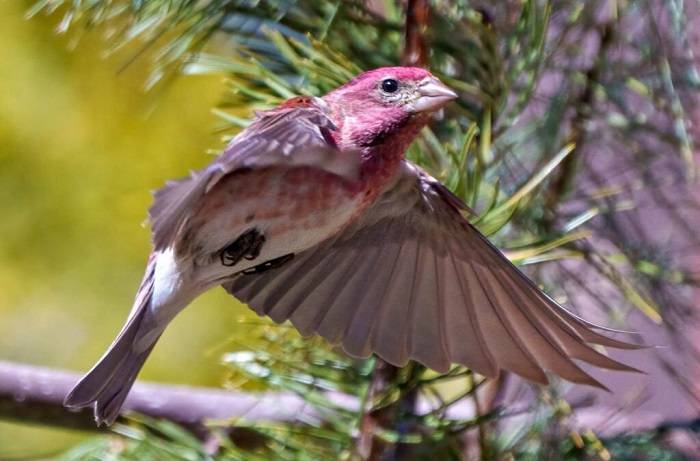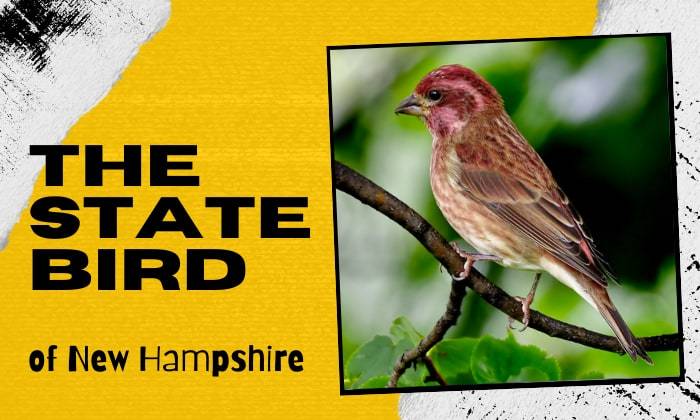Nestled in the heart of New England, New Hampshire boasts a rich tapestry of natural beauty, from its majestic mountains to its pristine lakes and forests. Among the state’s many treasures is its official bird emblem, the Purple Finch (Haemorhous purpureus). In this exploration, we’ll delve into the fascinating world of the Purple Finch, uncovering its habitat, behavior, and significance as a symbol of New Hampshire’s natural heritage.
The Purple Finch: A Vibrant Resident of New Hampshire
The Purple Finch, with its striking plumage and melodious song, is a familiar sight throughout New Hampshire’s woodlands, parks, and suburban areas. Named for the male’s distinctive rosy-purple hue, this charismatic bird is known for its cheerful presence and lively demeanor. With its stout bill and sturdy build, the Purple Finch is well-adapted to its forest habitat, where it forages for seeds, fruits, and insects among the branches of trees and shrubs.
Habitat and Range: Exploring the Purple Finch’s Territory
While the Purple Finch is found across much of North America, it is particularly abundant in the northeastern United States, including New Hampshire. Here, the bird thrives in a variety of forested habitats, from deciduous and coniferous woodlands to mixed forests and suburban landscapes. During the breeding season, males establish territories and sing to attract mates, while females build nests in trees or shrubs, where they raise their young amid the leafy canopy.
Behavior and Diet: Unraveling the Purple Finch’s Ecological Role
As omnivorous birds, Purple Finches have a diverse diet that includes seeds, berries, insects, and occasional small fruits. They are adept foragers, using their strong bills to crack open seeds and extract nutritious kernels. During the breeding season, males perform elaborate courtship displays, puffing out their chest feathers and singing elaborate songs to impress potential mates. Once paired, the female takes on the primary responsibility of incubating the eggs and caring for the young, while the male assists with feeding and defending the nest.
Symbolism and Significance: The Purple Finch as a Cultural Icon
For the people of New Hampshire, the Purple Finch holds special significance as the state bird, symbolizing resilience, adaptability, and natural beauty. Its cheerful song and vibrant plumage evoke feelings of joy and wonder, serving as a reminder of the state’s rich biodiversity and ecological heritage. Whether glimpsed flitting among the trees or heard singing from a backyard feeder, the Purple Finch inspires a sense of connection to the natural world and the importance of preserving it for future generations.
New Hampshire State Bird
While the Purple Finch remains a common sight in New Hampshire, it faces threats from habitat loss, climate change, and other human impacts. As stewards of the state’s natural resources, it is incumbent upon us to take action to protect and preserve the habitats upon which these birds depend. This includes conserving forests and green spaces, promoting sustainable land management practices, and supporting efforts to mitigate the effects of climate change on wildlife populations.
Related Post:
Cracking the Mystery: How Long Does It Take for Duck Eggs to Hatch?
Unlocking the Egg-Laying Mystery: When Do Ducks Start Laying Eggs?
Choosing the Perfect Pet Duck: A Comprehensive Guide
Discovering the Enigmatic World of Rare Duck Breeds
In conclusion, the Purple Finch serves as a vibrant symbol of New Hampshire’s natural heritage, embodying the resilience and beauty of the Granite State’s avian inhabitants. From its colorful plumage to its melodious song, this charismatic bird captivates the hearts and imaginations of birdwatchers and nature enthusiasts alike. As we celebrate the Purple Finch and its place in New Hampshire’s ecological tapestry, let us also renew our commitment to conservation and stewardship, ensuring that these magnificent birds continue to grace our forests and woodlands for generations to come.




